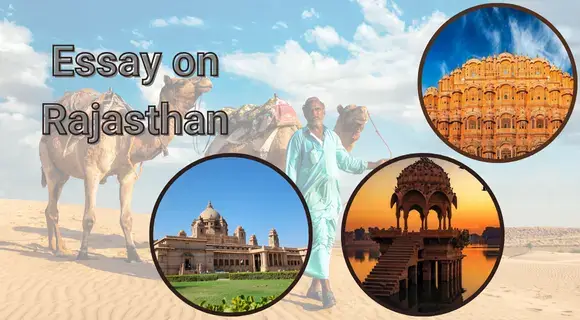Short Essay on Rajasthan in English
Rajasthan: Land of Kings and Colors
Rajasthan, which means “Land of Kings,” is truly royal. This lively state in northwest India has a rich history, beautiful architecture, and a colorful culture that’s hard to match.
Picture huge deserts with grand forts, stunning palaces straight out of stories, and busy cities filled with handicrafts and fabrics. That’s Rajasthan! The Thar Desert, with its golden sands, is an amazing sight, while the mighty Aravalli hills offer a refreshing retreat.
But Rajasthan’s true essence lies in its history. Magnificent forts like Mehrangarh in Jodhpur and Jaigarh in Jaipur tell tales of brave kings and epic battles. Palaces like Hawa Mahal in Jaipur and Umaid Bhawan Palace in Jodhpur show the architectural brilliance of the past.
The state is also a burst of colors. Women in bright sarees and men in colorful turbans add to the lively atmosphere. Local markets are full of hand-woven fabrics, detailed jewelry, and traditional Rajasthani art. Don’t miss the chance to see Rajasthani folk dances, where graceful moves match lively music.
Rajasthan has something for everyone. Whether it’s exploring the desert on a camel, admiring forts and palaces, or immersing in its vibrant culture, this land of kings guarantees an unforgettable experience.
Rajasthan: A Tapestry of History, Culture, and Color
Rajasthan, nestled in the northwest corner of India and aptly named “Land of Kings,” offers a rich blend of history, architecture, and culture that enchants every visitor. From the golden sands of the Thar Desert to the majestic Aravalli hills, and from the intricate crafts to the lively festivals, Rajasthan presents a tapestry of experiences unlike any other.
A Land with a Glorious Past:
Rajasthan’s history dates back centuries, evident in its numerous forts and palaces scattered across the landscape. These structures, perched atop hills or overlooking bustling cities, narrate stories of valorous kings and epic battles. The Mehrangarh Fort in Jodhpur, with its imposing seven gates, symbolizes Rajput bravery. Meanwhile, the Jaigarh Fort in Jaipur showcases advanced military technology of its time with its intricate cannons and defense mechanisms. The City Palace in Udaipur stands as a stunning blend of Mughal and Rajput architecture, reflecting the cultural fusion that shaped the region.
Architectural Marvels and Artistic Legacy:
Rajasthan’s architectural marvels extend beyond forts and palaces. The Hawa Mahal (“Palace of Winds”) in Jaipur, with its unique facade adorned with intricate latticework for natural ventilation, is a testament to the region’s architectural ingenuity. The Umaid Bhawan Palace in Jodhpur, one of the world’s largest private residences, showcases the opulence of the princely era.
A Vibrant Cultural Kaleidoscope:
Rajasthan’s rich culture goes beyond its historical landmarks. At its heart lies a vibrant tapestry of attire, traditions, and festivals. Women draped in colorful sarees and men adorned with intricately tied turbans bring streets alive with a riot of colors. Traditional Rajasthani folk music fills the air, accompanied by graceful movements in folk dances like the Ghoomar and Kalbeliya.
Craftsmanship: A Legacy Passed Down:
The cultural vibrancy of Rajasthan is further accentuated by its unique crafts. From intricately woven Bandhani textiles to colorful leheriya sarees, from handcrafted blue pottery of Jaipur to silver and lac jewelry, each piece reflects stories and traditions passed down through generations.
Culinary Riches:
Rajasthani cuisine adds another layer to the state’s vibrant heritage. Utilizing local spices, traditional cooking methods, and unique ingredients like camel milk and millet, it offers a culinary experience unlike any other. From the fiery Laal Maas to the tangy Dal Baati Churma, each dish tantalizes the taste buds, providing a glimpse into the region’s rich culinary heritage.
Beyond Tourist Hotspots:
While cities like Jaipur, Jodhpur, and Udaipur are popular tourist destinations, Rajasthan offers much more beyond the beaten track. The Thar Desert offers a unique experience with its vast expanse of golden sands and star-studded nights. Visitors can explore the desert on camel safaris, immerse themselves in the colorful culture of nomadic tribes, or simply enjoy the tranquility of desert nights under a canopy of stars. The Aravalli hills provide a serene escape with scenic trails, hidden waterfalls, and the serenity of nature amidst rugged beauty.
Challenges and a Forward Gaze:
Despite its rich heritage and vibrant culture, Rajasthan faces challenges like water scarcity, poverty, and unemployment. However, initiatives in sustainable water management, promoting handicrafts, and developing eco-tourism offer promising solutions. Rajasthan’s future lies in striking a balance between preserving its cultural heritage and fostering sustainable development. By embracing its unique identity and adapting to the needs of the future, Rajasthan can continue to be a land of captivating history, vibrant culture, and unforgettable experiences for generations to come.
In conclusion, Rajasthan offers a kaleidoscope of vibrant experiences, each more enchanting than the last. From its historical landmarks and architectural wonders to its diverse traditions and artistic legacy, the state provides a glimpse into a glorious past while embracing the present. Exploring Rajasthan promises an immersive experience, leaving every visitor with a sense of wonder, joy, and deep appreciation for the land of kings and colors.
